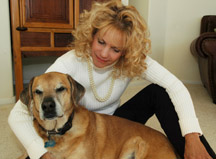Recently at a restaurant, I watched a woman trying to have lunch with a friend as she struggled with her two-year old daughter. The little girl whined and clung to her pant leg like a kitten to a silk drape. Nothing shook her off. She tried to distract her with crayons. She told her to "stop it" in more ways than I could remember--sweetly, firmly, commandingly, pleadingly. Finally, irritated and frustrated with the situation, she yelled at her, "Do you want me to take you home? Then sit still!"
Lucky (at least in short-term considerations) for the mother, the child did. She pouted, hurt and confused, and finally sat still. But a golden opportunity was missed as the mother misinterpreted a terribly important communication from the child.
What do children want when they cling to us? What are they asking for? What are we supposed to do when we have so many things to accomplish in one day, when we're half-way through the to-do list and the baby once again needs our attention? And how are we even supposed to know what they need our attention for?
The Course of Fear and the Need for Safety
According to attachment theorists, the first question on the mind of every human being born into the world (and some might argue not just humans) is: Am I safe? Can I get food? Shelter? Can I survive?
It is not a cognitive question--there is no language facility at that age. It's a cellular one. It is embedded in us in the same manner as our abilities to blink, swallow and breathe. We don't have to think about it consciously. We just seek it.
Ironically, we are born the most helpless of all creatures on earth. For years, we are at the wholesale mercy of those into whose care we were born. We can't walk, talk, or understand the rules of engagement on almost any level. It is natural and logical that the primary genetic compulsion is: Seek safety.
My husband, who is one of the wisest men I've ever known, thinks there's a poetic irony in this--that colicky babies who are incapable of uttering a single clear idea can somehow yank middle-aged people out of bed after a late night party, make them put on their jeans and shoes and take them for a 3 a.m. ride in the car to nowhere.
Of course, that is precisely the point: they don't use words. But they do SIGNAL. They scream. They cry. They fuss. They pout. They cling.
And if the primary need is for safety, what do they signal for?
Proximity and relief. The promise of safety.
They need to know that their caretakers are available, that their needs will be met, that they will be protected, fed, warm, and loved. They need to be seen.
If those basic needs are not met with some regularity, they can become fearful and angry.
So what did that little girl at the restaurant need? In all likelihood, she was disconcerted by her mother's focus on her friend and needed some temporary reassurance that mom knew she was still there. She was in the phase Margaret Mahler called "Rapprochement."
I see it all the time in young children and even in some adults who come to me for treatment. It is part of the normal phase of separation-individuation in which the child begins to see the parents as separate individuals. In this phase, children who have developed a healthy, independent sense of exploration and personal identity (as distinct from the mother's) begin to "re-approach."
You see this behavior a great deal in playgrounds. The child will run about on his or her own, then periodically come back to home base for a touch, a smile, an acknowledgement. So long as he has his caretaker in his sights and within quick reach, he is safe to continue exploring his new world.




